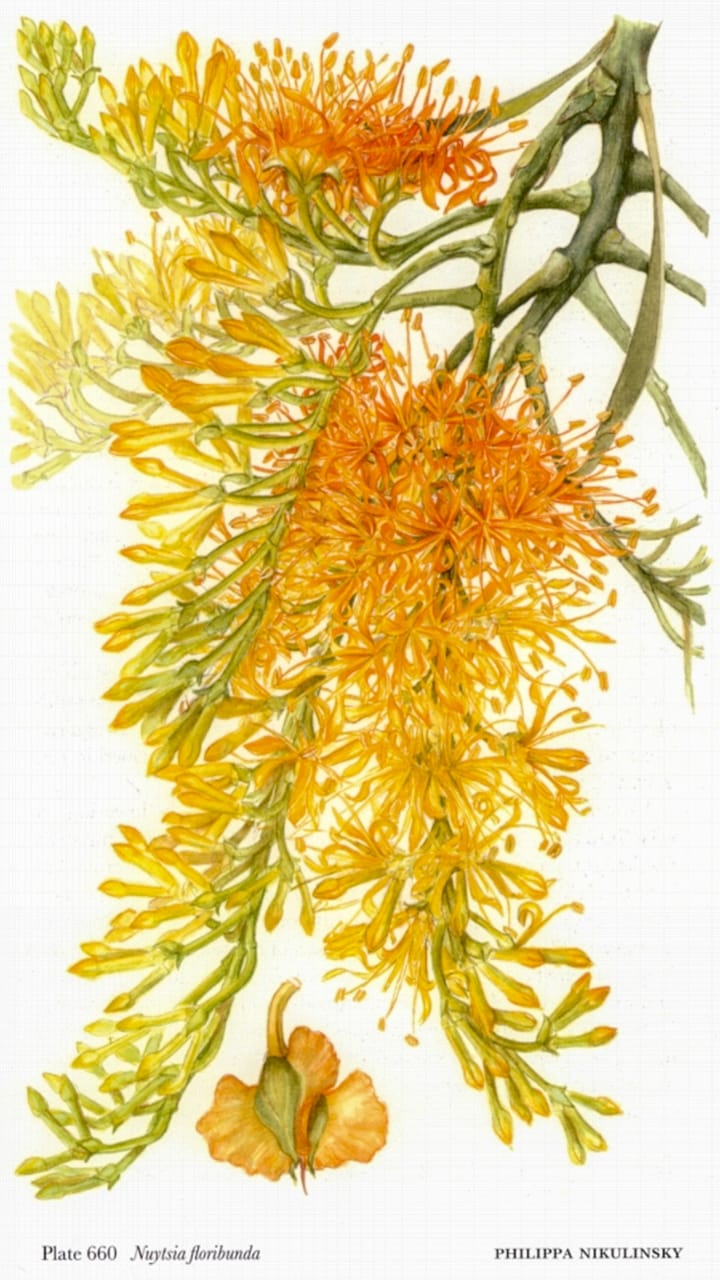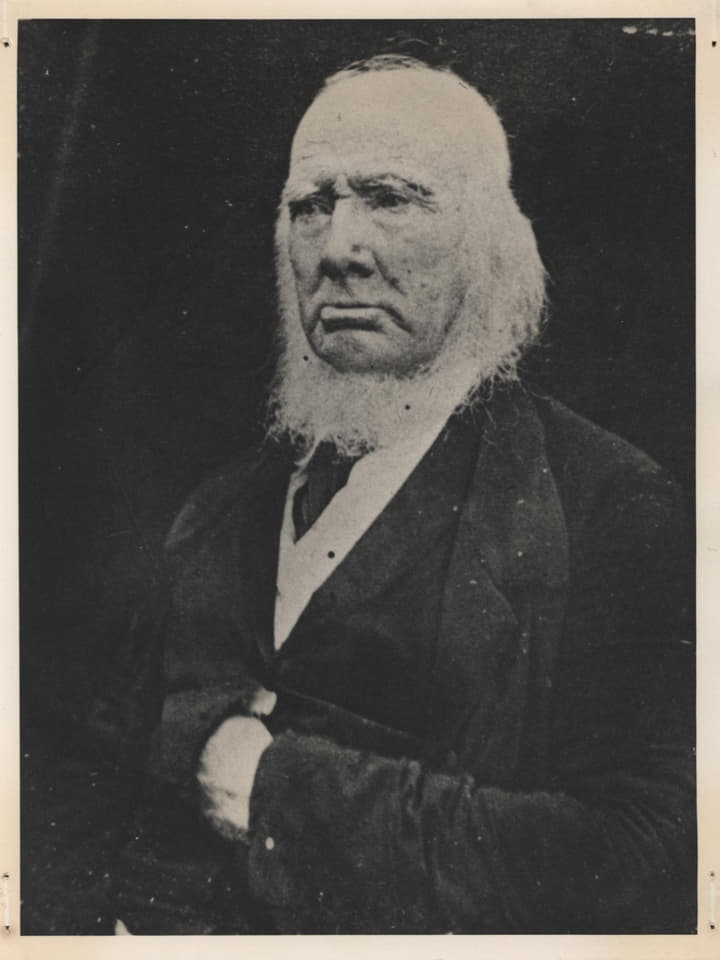Burgeoning Birak
Nuytsia Floribunda
Nuytsia Floribunda, commonly known as Christmas tree in Australia, or more the Western Australian Christmas tree, is a species of flowering plant native to Western Australia. It is a member of the mistletoe family and is the only species in the genus Nuytsia. 'Moodjar' is the Nyungar name for the plant, but it is also called moojerool, munjah or mutyal, and it has a deep spiritual significance.
Family: Loranthaceae
Scientific Name: Nuytsia Floribunda
Nyungar Name: Moodjar
Common Name: WA Christmas Tree
History:
The first description was published by Jacques Labillardière in Novae Hollandiae Plantarum Specimen (1805) as Loranthus floribundus, the specific epithet describing the profuse flowers he had observed at Esperance. The botanist Robert Brown published a remark on the species in 1831, giving a new genus name without a formal description. A description was published by George Don using Brown's name Nuytsia, an epithet that commemorates the seventeenth-century Dutch explorer Pieter Nuyts.
The regional name of 'Christmas tree' has been applied since the nineteenth century. James Drummond noted in 1843 that the colonists at the Swan River referred to this species as the 'fire-tree', given for the resemblance of the inflorescence to a fire in its habitat. William Milligan reported that the first colonists used the term 'cabbage tree', a reference to its fragile, white and spongey branches.

Growing a Moodjar Tree in Your Garden
Adapted from Gold after the Rainbow by Hazel Dempster
Nothing can brighten up your day more than the brilliant, bright flame-coloured blooms of the Moodjar Tree or the WA Christmas Tree, Nuytsia floribunda. This golden wonder signals the beginning of a festive season and welcomes Christmas each year.
The honey scented flowers represent a deep and significant spiritual connection for the First Nations People who have revered this tree for thousands of years. And for this reason, picking flowers of this majestic tree is an absolute no-no.
This magnificent upright flowering tree grows to about 6 to 15 metres in height, thrives in a range of red, yellow, and grey sandy soils (often found near wintery wet places), and is tolerant of long dry summers. Given that this is a local species, our local soils are the most suitable for it and no special changes are required to be made to accommodate its growth.
The WA Christmas Tree is often a popular request for home gardens because it is such a striking and unique tree. Larger gardens and landscaped areas are a great choice where the tree’s natural growth pattern can be properly accommodated. A natural leaf litter is preferred in place of mulch. And regular watering especially during the dry Birak and Bunuru months is required to allow the tree to establish a strong root system.
Normally, the growth in the wild begins when the papery seeds (formed after the profusion of flowers) float with the wind from the tree to settle on the surrounding grounds. Germination may take place after the Djeran rains. The haustoria or parasitic roots from the seedlings reach out to latch onto the roots of multiple host species found in the ground. This provides the tree with nourishment during the first few years. However, a mature tree can exist alone if necessary.
Suckers spread in rhizome formation from the seedlings as the tree matures, until one or more then extend up to become the trunk or the clonal trunks. These trunks reach up to flower some ten to fifteen years later. Flowering can be hastened dramatically with wildfire and trees are often seen flowering after a fire in the wild.
Growing a Moodjar Tree
There are two main ways to grow a Moodjar Tree in your garden. (a) with seed or (b) with cuttings. Both methods require you to obtain a flora license first in order to be able to collect the necessary propagation materials.
- By seed
Germination from freshly collected seed is considered to be easy by most growers. Seed is collected as it matures on the tree within few weeks of flowering. The papery seed is settled upright onto the surface of a tray of native plant seedling mix and kept moist.
After germination, the seedling is transferred into a forestry tube to continue to grow until it is of a suitable size for transplanting into a pot with a host. Suggestions for host plants are dichondra, local kangaroo paws and native grasses at these early stages. Even some exotic species such as carrot seedlings and Lagerstroemia (crepe myrtle) species have proven to be successful hosts.
- With cutting
As the trees produce upright suckers from the thick underground rhizomes, suitable cutting materials can be taken from this succulent new growth or from suckers after the tree has finished flowering. Use of purple clonex is recommended as hormone dipping solution for the propagation. Once cuttings have grown roots, these cuttings can then be potted up with a host plant (as mentioned above).
If you are interested in learning more about this fascinating tree, participating in our upcoming Propagation Workshops or in Volunteering with us, contact us today.
“Gold after the Rainbow” by Hazel Dempster, Published in WA Gardener Summer 2003 and Wildflower Society of Western Australia Newsletter February 2004 Edition
James Drummond
Early 1787 – 26 March 1863.
James Drummond was a pioneering botanist and explorer who made significant contributions to the study of Western Australian flora. He emigrated to Western Australia in 1839, where he became a botanical collector for the colonial government.
Drummond is known for his extensive collections of Western Australian plants, which he made during his travels throughout the state. He collected and described many new species of plants, and his collections form the basis of the Western Australian Herbarium at the University of Western Australia.
He was also an accomplished illustrator, and his work helped to establish Western Australia's reputation as a center of botanical research and discovery. He is considered one of the founders of Western Australian botany, and his work helped to establish the state's reputation as a center of botanical research and discovery.
Drummond made several expeditions into the unexplored regions of the state and contributed to the field of natural history. Drummond died in 1877 at the age of 61, but his legacy as a botanist and explorer continues to be recognized and celebrated to this day.
"In the history of the botany of Western Australia, the name of James Drummond stands out prominently as that of a man who devoted his life to the collection and study of the flora of that State, and whose labours have been of the greatest value in the development of our knowledge of the plant life of Australia."
– Joseph Maiden, Director, Royal Botanic Gardens, Sydney


I have several mature Mooja trees on my garden near Meelup but they hardly flower less than 1% of the trees produce flower. Is there anything I can do to promote flowering?
It’s important to note that these trees might take a long time, even up to 20 years, to flower. So it’s a real test of patience. To encourage flowering in Moodjar trees, you might find these guidelines useful: sandy or sandy loam soil, accommodating a range of soil pH levels (acidic, neutral, alkaline), and maintaining moist soil with proper drainage. Minimizing nutrient intervention is generally recommended as they partly sustain themselves. They need adequate sunlight (about 4-5 hours daily). Bear in mind that these are general guidelines and may not guarantee success in every case. For more specific advice tailored to your garden’s conditions, consulting local horticulturists or native plant nurseries is advisable
Hi Geoff, I have had Wayne, from Madora, interested in talking to you about your Mooja trees, and who also has some great advice on flowering for you. Can you give the Wetlands Centre a call on 08(9417 8460) so I can pass his contact details on to you? Thanks